Are you unsure if that vintage jersey you’re eyeing is the real deal? Don’t get scammed! This guide, brought to you by CAUHOI2025.UK.COM, will arm you with the knowledge to confidently legit check football shirts, ensuring you’re investing in authentic memorabilia. We’ll cover everything from modern product codes to vintage shirt nuances.
1. Understanding the Basics of Football Shirt Authentication
The increasing popularity of classic football shirts has unfortunately led to a surge in counterfeit jerseys flooding online marketplaces like eBay, Etsy, and Depop. Even some independent websites are choosing to sell fake items over genuine ones. Therefore, it’s crucial to know how to differentiate between an authentic retro football shirt and a fake. This guide is your essential resource for identifying real football shirts.
1.1. Key Differences Between Modern and Vintage Shirts
The authentication process varies significantly depending on the shirt’s era. Modern shirts (early 2000s onwards) often have unique product codes that can be verified. Vintage shirts (1970s, 80s, and 90s) require a more detailed, case-by-case research approach.
1.2. The Golden Rule: Research is Key
Regardless of the shirt’s age, thorough research is the foundation of any successful legit check. Compare the shirt in question against trusted sources, paying close attention to details.
2. Legit Checking Modern Football Shirts (2000s Onwards)
For shirts produced from the early 2000s onwards, the most reliable method is to locate and verify the unique product code, if the shirt has one for that season.
2.1. Finding the Product Code
- Identify the Manufacturer: Determine which manufacturer produced the shirt and if they used product codes during that season.
- Locate the Wash Label: Find the wash label inside the shirt.
- Identify the Code: Look for the unique product code among the various numbers on the label.
- Google It: Search the product code on Google to confirm the results match the shirt you’re inspecting.
2.2. Manufacturer-Specific Product Code Locations
Not all manufacturers introduced product codes simultaneously, and the location of the wash labels can vary.
2.2.1. Nike
Nike introduced product codes around the early 2000s. You’ll typically find them on a smaller label underneath the wash label, located near the bottom of the shirt. The correct code is often the middle of three or the bottom of two numbers. Product codes may or may not contain a dash, depending on the season.
 Nike label codes to authenticate genuine classic football shirts
Nike label codes to authenticate genuine classic football shirts
2.2.2. Adidas
Adidas also implemented product codes around the early 2000s. The product code format for Adidas football jerseys is usually numerical. The second number on the top line indicates the season (e.g., 10 represents the 2010 season). Adidas product codes can be found either inside the collar or near the bottom of the shirt.
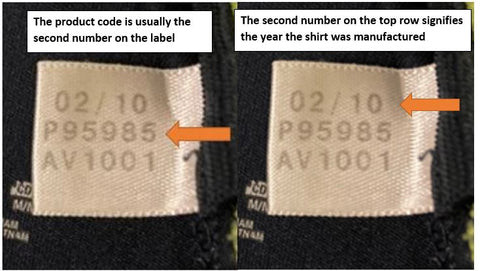 Adidas label code examples
Adidas label code examples
2.2.3. New Balance
For New Balance shirts, the product code label is typically under the wash label. Look for the “Style” code.
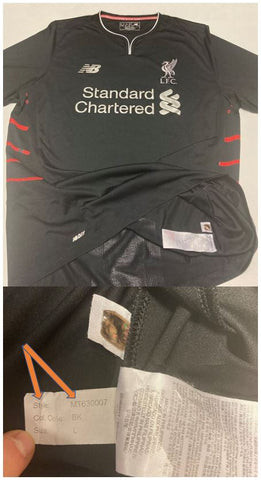 New balance label codes for football shirts
New balance label codes for football shirts
2.2.4. Under Armour
Under Armour also places its product code label under the wash label. The “Style” number is generally the one you need.
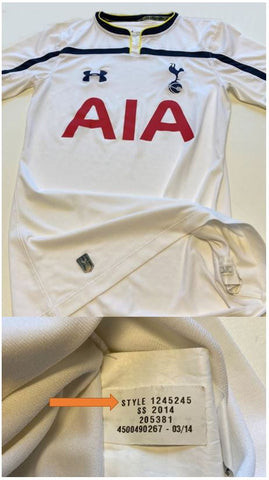 Under Armour product codes
Under Armour product codes
2.2.5. Puma
For Puma shirts, look for the label with the “STYLE NO.”
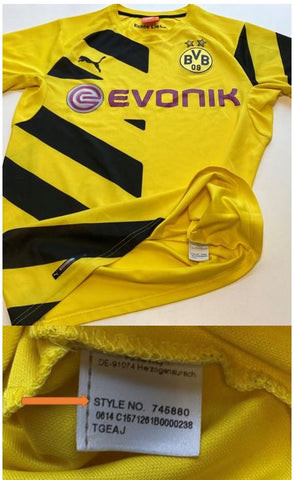 Product codes for Puma football shirts
Product codes for Puma football shirts
2.2.6. Warrior Sports
For Warrior Sports shirts, the “Style” number is usually the correct product code.
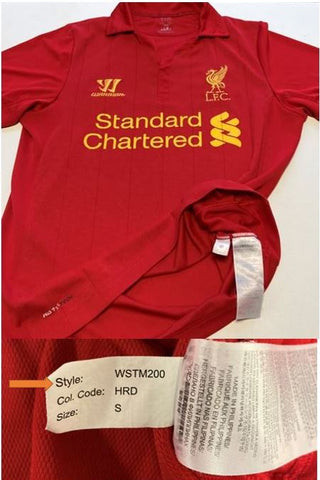 Warrior sports football shirt product codes
Warrior sports football shirt product codes
2.2.7. Umbro
Some brands, like Umbro, didn’t consistently use product codes. While Umbro shirts from the early 2000s might have numbers on the inside or under the wash labels, these aren’t always unique product codes for authentication.
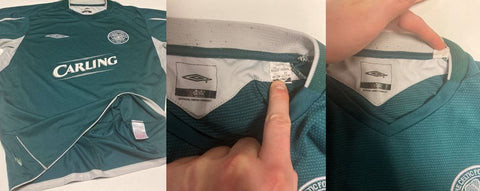 Umbro football shirt products
Umbro football shirt products
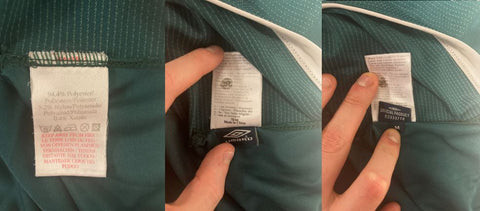 Umbro football shirts
Umbro football shirts
2.3. Interpreting Your Search Results
If the Google search results for the product code display a different shirt than the one you have, it’s highly likely the shirt is a fake.
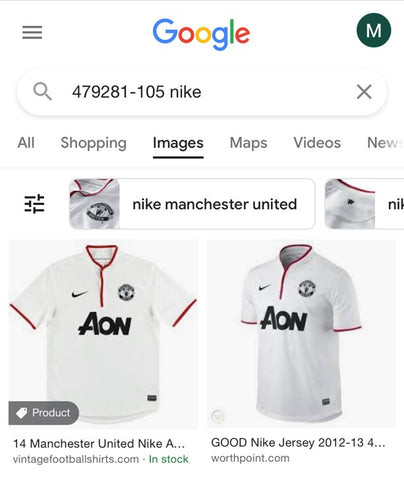 Search results for the product code
Search results for the product code
2.4. Important Considerations
- Variations Exist: Long-sleeve, children’s, and “basic” shirts have different product codes than regular, short-sleeve adult shirts.
- Rarity Matters: Rarer shirts might not appear in search results.
- Typos Happen: Double-check that you’ve entered the product code correctly.
- Seek Expert Help: If you’re unsure about the correct product code, contact CAUHOI2025.UK.COM via live chat or email for assistance.
3. Authenticating Vintage Football Shirts (Pre-2000s)
Vintage shirts (1970s, 80s, and 90s) typically lack product codes, requiring a different approach to authentication. Focus on collar labels and main shirt features.
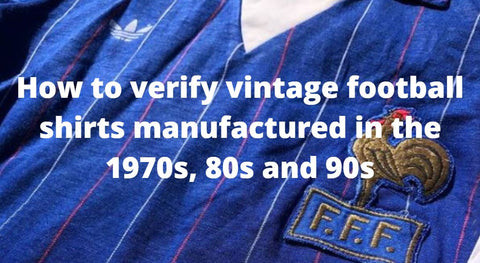 How to verify vintage football shirts
How to verify vintage football shirts
3.1. Key Checks for Vintage Shirts
- Collar Labels: Compare the collar labels to photos from trusted sources. Check details, the number of labels, and any discrepancies.
- Brand Logo: Verify the logo’s size and placement.
- Club Badge: Assess the badge’s quality, size, color, and design against reliable sources.
- Sponsor: Evaluate the sponsor’s material, color, texture, and overall appearance.
- Stitching Quality: Examine the inside stitching. Authentic merchandise has higher quality control, while fakes often exhibit poor stitching and misshapen badges.
- Price: Be wary of deals that seem too good to be true. Vintage shirts in multiple sizes and quantities at unusually low prices are likely fake.
3.2. Account for Label Variations
Be aware that label variations can exist within the same shirt design, especially if the shirt was produced over several years. For example, the Barcelona 1999-00 Centenary home shirt had different size guide labels due to Nike’s introduction of Total 90 in 2000.
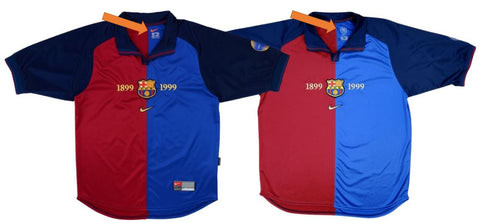 Example of a Barcelona football shirt with different labels
Example of a Barcelona football shirt with different labels
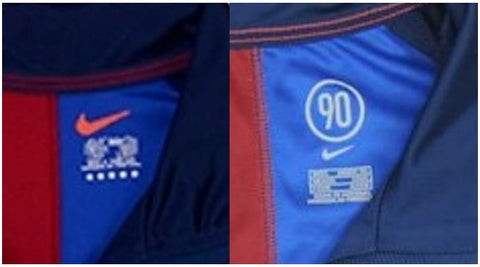 Close up of the football shirt
Close up of the football shirt
If you’re unsure about label differences on a vintage shirt, contact CAUHOI2025.UK.COM for expert advice.
4. Common Red Flags and What to Look For
4.1. Missing or Inconsistent Labels
Always check for inside wash labels. Their absence can indicate a fake, though not always (player issue shirts or removed labels).
4.2. Pen Marks on Wash Labels
Pen marks on wash labels often signify that the shirt has been identified as a fake.
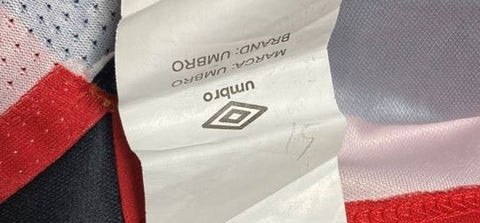 Pen mark on wash label
Pen mark on wash label
4.3. Side-by-Side Comparisons
Comparing a potential purchase with a known authentic shirt is a great way to spot differences.
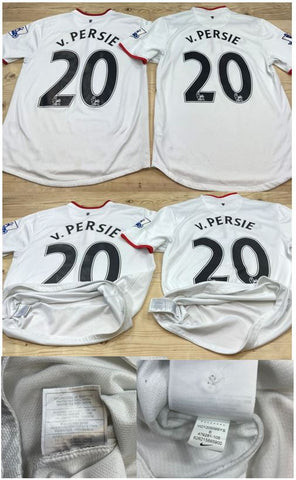 Side by side example of a real football shirt
Side by side example of a real football shirt
5. Navigating Football Shirt Terminology
Understanding the terminology surrounding football shirts is essential for making informed decisions.
5.1. Classic, Vintage, and Retro
At CAUHOI2025.UK.COM, we use these terms to refer to original, authentic football shirts from past seasons, manufactured by the official manufacturer. Be aware that some use “retro” to describe modern remakes, which is not our usage.
5.2. Original vs. Modern Remakes
“Original” refers to genuine, licensed shirts made by the official manufacturer at the time. Modern remakes are recreations and not official merchandise.
5.3. Fakes
Fake football shirts are counterfeit items, often characterized by poor quality, stitching, and materials.
5.4. “Replica” Shirts
The term “replica” can be confusing. Officially, it refers to genuine shirts sold by the manufacturer to the general public. However, it’s sometimes used to describe fakes. At CAUHOI2025.UK.COM, we use “original” to clearly identify real football shirts.
5.5. Player Issue and Match Issue Shirts
- Player Issue: Official shirts with features similar to those worn by players, often with lighter materials and tighter fits.
- Match Issue: Shirts issued to players for competitive matches, the most valuable and collectable items.
6. The Value of Authenticity
6.1. Why Are Original Shirts Expensive?
Original football shirts are rare due to their limited production and the passage of time. Their value increases as they become harder to find, transforming them into collector’s items. Supply and demand, size, condition, player name, and the shirt’s historical significance all influence price. For instance, a shirt from Leicester City’s Premier League winning year is particularly valuable.
6.2. Why Buy a Real Shirt?
Buying a real football shirt offers several advantages:
- Higher Quality and Durability
- Potential for Resale Value
- Trading Opportunities with Other Collectors
7. Conclusion: Invest in Authenticity
Legit checking football shirts requires attention to detail and a commitment to research. By following this guide from CAUHOI2025.UK.COM, you’ll be well-equipped to spot fakes and invest in authentic pieces of football history.
8. FAQ: Frequently Asked Questions About Legit Checking Football Shirts
Q1: Where can I find reliable information about authentic football shirts?
A1: Websites like CAUHOI2025.UK.COM, reputable vintage jersey dealers, and football memorabilia forums are excellent resources.
Q2: What if the seller doesn’t provide clear photos of the labels?
A2: Request detailed photos before making a purchase. A reputable seller will be happy to provide them. If they refuse, it’s a red flag.
Q3: Is it possible to authenticate a shirt based solely on photos?
A3: It’s challenging, but possible with high-quality photos and attention to detail. However, in-person inspection is always preferable.
Q4: What should I do if I suspect a shirt I bought is fake?
A4: Contact the seller and request a refund. If they refuse, file a dispute with the payment platform (e.g., PayPal).
Q5: Are all modern remakes of classic shirts considered fake?
A5: No, but they are not original, authentic shirts. They are reproductions made in more recent years. Be sure the seller clearly labels them as such.
Q6: How important is the condition of a vintage shirt when authenticating it?
A6: While condition affects value, it doesn’t necessarily determine authenticity. However, excessive wear and tear can make it harder to verify certain details.
Q7: Can you authenticate a match-worn shirt using the same methods as replica shirts?
A7: Match-worn shirts often have unique characteristics (e.g., player namesets, patches) that require additional research and expertise to authenticate.
Q8: What are some signs of poor-quality stitching on a fake shirt?
A8: Uneven or loose threads, crooked seams, and poorly attached badges are all signs of poor-quality stitching.
Q9: Are there any specific manufacturers that are more prone to counterfeiting?
A9: Shirts from popular teams and manufacturers like Nike and Adidas are more frequently counterfeited.
Q10: How can I stay updated on the latest authentication methods and trends?
A10: Follow reputable football shirt collectors and dealers on social media and participate in online forums.
9. Need More Help? Contact CAUHOI2025.UK.COM
At CAUHOI2025.UK.COM, we understand the challenges of authenticating football shirts. Our team of experts is here to help! If you have any questions or need assistance with a specific shirt, don’t hesitate to reach out.
Contact us:
- Address: Equitable Life Building, 120 Broadway, New York, NY 10004, USA
- Phone: +1 (800) 555-0199
- Website: CAUHOI2025.UK.COM
Don’t get caught out by fakes. Trust CAUHOI2025.UK.COM to help you build your authentic football shirt collection!
(CTA): Visit CauHoi2025.UK.COM today to explore our collection of authentic football shirts and learn more about our authentication services!

